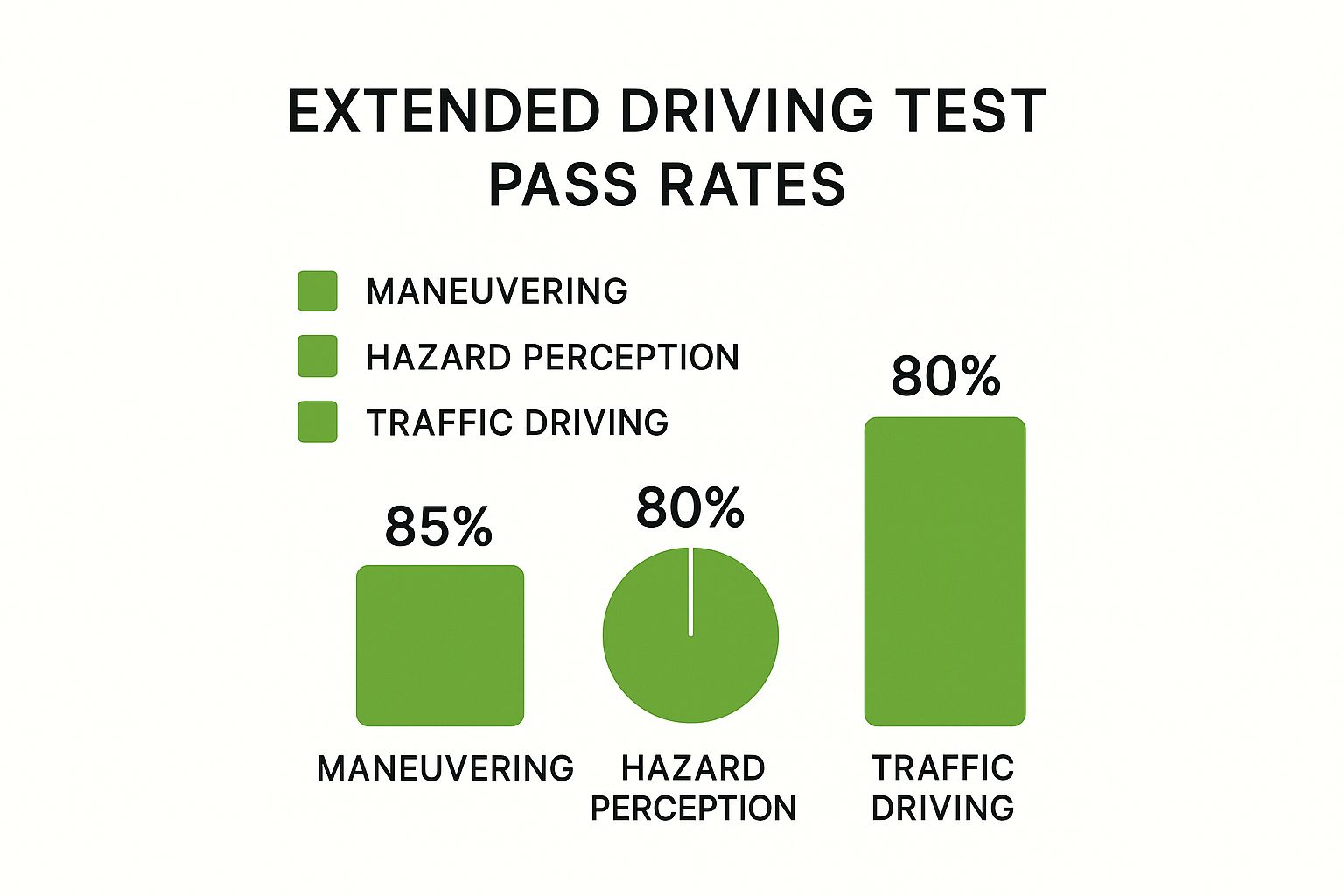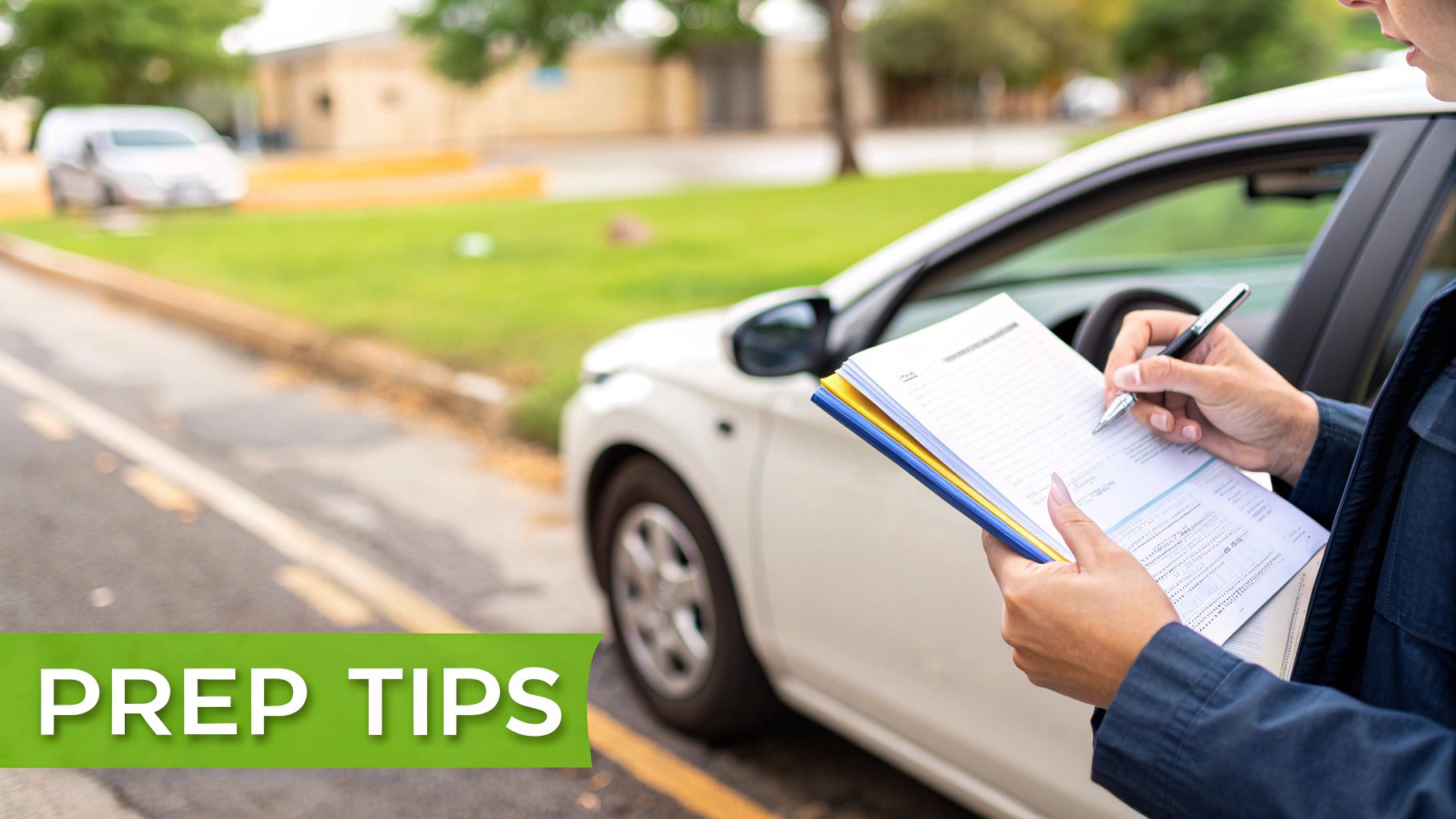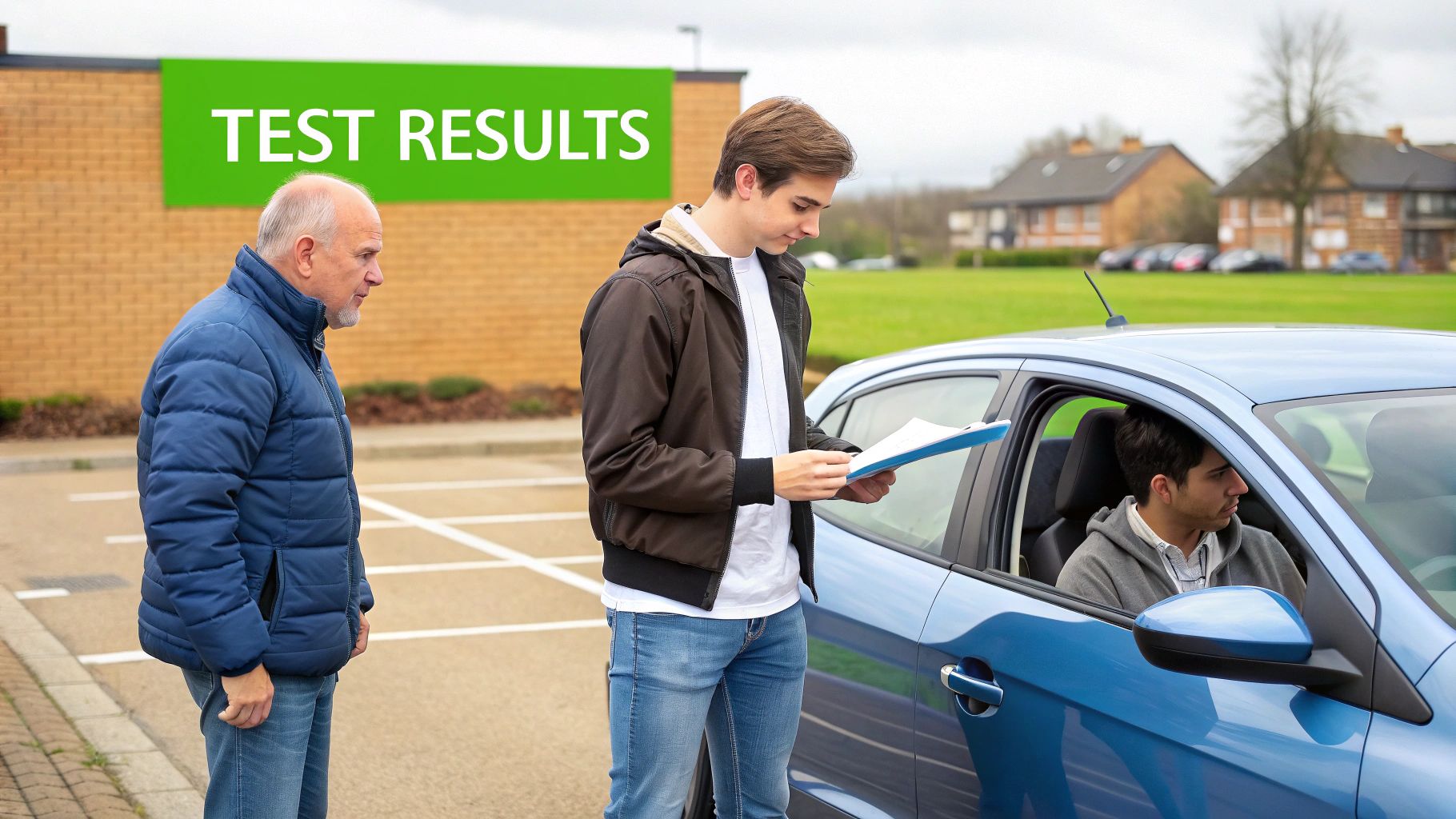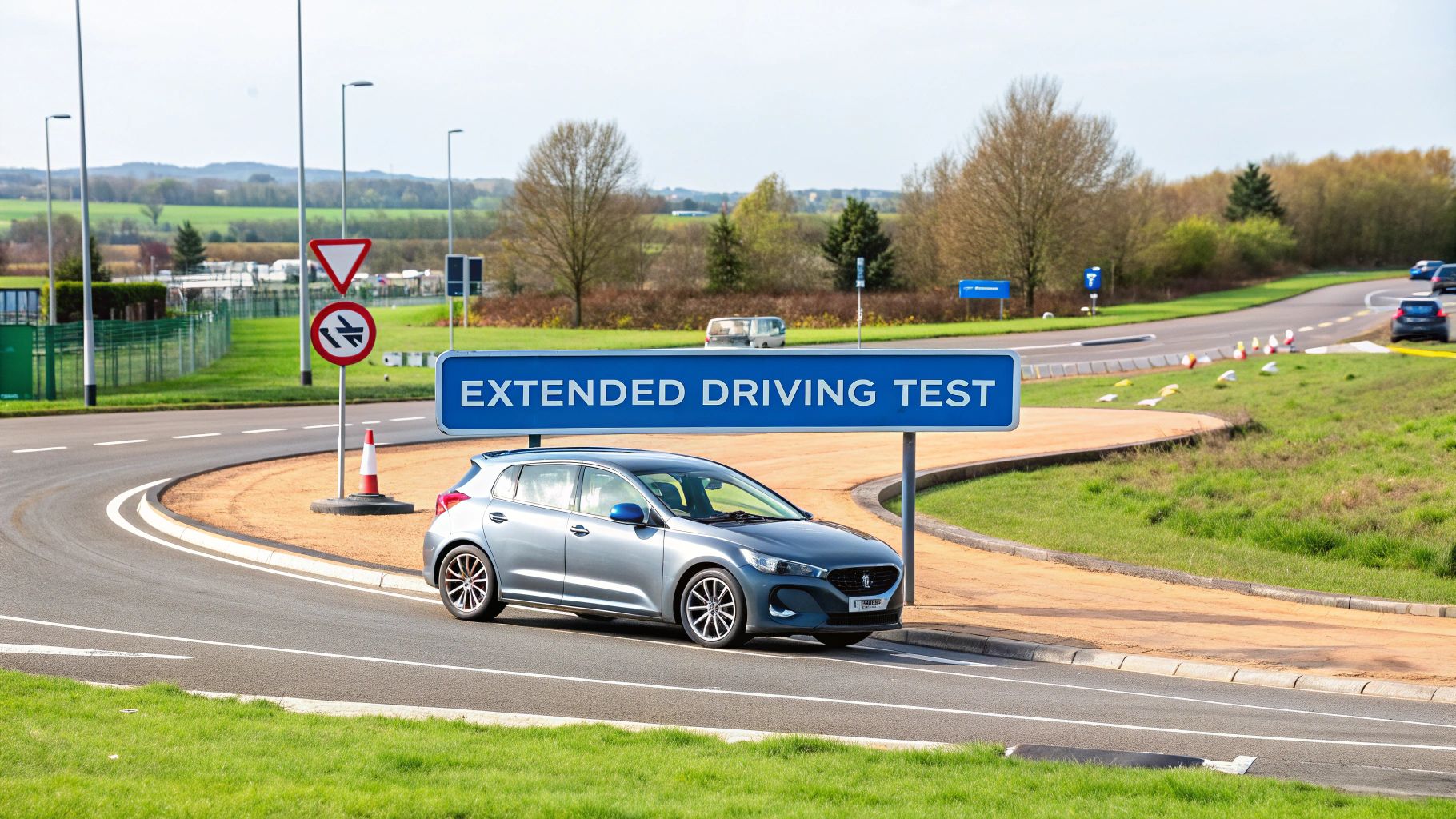Understanding The Extended Driving Test: Beyond The Basics

Think of a standard driving test as a short quiz, giving a brief snapshot of your driving skills. The extended driving test, however, is more like a final, in-depth exam. It’s not just about proving you can handle a car; it’s about showing you can manage the sustained pressure and complex decision-making of real-world driving over a longer period. This tougher assessment exists for a serious reason: to improve road safety and confirm that certain drivers are genuinely competent before they get back behind the wheel.
The main difference is its length and intensity. The extended driving test, which became part of UK driving assessments in December 2017, was introduced to address road safety concerns. It nearly doubles the standard test time, lasting for approximately 70 minutes instead of the usual 38. This extra time isn't just filler; it’s carefully used to create a more realistic and demanding driving scenario that reflects the daily challenges on UK roads. You can find more details on the evolution of driving tests from sources like the RAC.
A More Demanding Assessment
This test is much more than just a longer drive. The format is specifically designed to assess a driver's concentration and stamina over an extended time. While a standard test has a relatively short independent driving section, the extended version lengthens this considerably. For instance, you could be asked to follow a sat nav for a full 20 minutes, navigating unfamiliar and busy routes, which demands a high level of continuous focus.
This increased demand is intentional. It aims to bridge the gap between simply passing a test and being a consistently safe driver. It checks how you perform when mental fatigue might begin to affect your judgement—a known factor in many road accidents. By observing a driver for over an hour, the examiner gets a far more accurate picture of their real driving habits, hazard perception, and ability to make good decisions under pressure. The goal is to ensure a driver can handle the psychological demands of the road, not just the mechanical ones. If you're preparing for one, our guide on extended driving test tips offers valuable, specialised advice.
Who Actually Needs The Extended Driving Test?
Not every driver will ever encounter the extended driving test. It's an assessment reserved for specific situations and isn't a standard part of learning to drive. Think of it like this: the regular practical test is the main gateway to getting your full licence. The extended test, however, is a mandatory reassessment—a much tougher second chance ordered after a serious driving incident. You can't just opt to take it instead of the standard test.
The most common path to an extended driving test is through a court order. This typically follows a driving disqualification, where a judge makes passing this more rigorous test a condition for getting your licence back. The goal is to ensure you can demonstrate a much higher level of competence and safety before you're allowed on the road again.
Court-Ordered Scenarios
A court will usually mandate an extended driving test for serious driving offences that cast significant doubt on a driver's judgement and safety awareness. Common reasons for this include:
- Dangerous Driving: This applies to convictions where driving falls far below the standard of a careful and competent driver, in a way that is obviously dangerous.
- Aggravated Taking of a Vehicle: This is when a vehicle is taken without permission and results in an accident causing damage.
- Causing Death by Dangerous Driving: In such tragic circumstances, passing this test is almost always a requirement to regain a licence.
- Specific Drink or Drug Driving Offences: While not every drink-driving conviction leads to an extended test, courts can impose one for repeat offenders or particularly serious cases.
The court uses its discretion, taking into account how serious the offence was and the driver's history. The main purpose is to confirm that the individual has not only completed their ban but has also corrected the unsafe behaviour that led to it in the first place.
Voluntary Considerations
Although you can't book an extended test voluntarily through the DVSA's system, the idea behind it offers a valuable lesson. If you're a driver dealing with extreme anxiety or returning to the road after a very long break, aiming for the skill level demanded by the extended test is an excellent benchmark.
Discussing this higher standard with your driving instructor can help you build exceptional confidence and skill. Even if you're only sitting the standard test, preparing as though you were facing the extended one ensures you're ready not just to pass, but to be a truly safe and capable driver for life.
Inside The Extended Test: What Those Extra 30 Minutes Really Mean
Have you ever wondered what exactly fills the extra time in an extended driving test? It’s not just about making the standard test longer. Think of it as the difference between a quick sprint and a marathon. Every additional minute is there for a reason, designed to paint a complete picture of your driving skills when you’re under pressure for a sustained period.
The main point of the extra time is to assess your endurance and consistency, which a shorter test might not fully reveal. It pushes beyond basic manoeuvres to see how well you maintain concentration and make safe decisions over the course of a more realistic journey. A large portion of this is dedicated to extended independent driving and tackling more complex, real-world parking scenarios.
A Deeper Dive Into The Components
The extended test is structured to feel like a more demanding drive. The examiner isn't just checking off boxes; they are watching how you handle potential fatigue and keep safety as your top priority for the entire 70-minute duration. Key elements include:
- Extended Independent Driving: This is a central part of the assessment. You’ll be asked to follow directions from a sat nav or by reading road signs for a considerable length of time, typically around 20 minutes.
- Complex Manoeuvres: You will face tasks that demand more precision. This could involve pulling up on the right-hand side of the road, reversing for two car lengths, and then safely rejoining the flow of traffic.
- Varied Road and Traffic Conditions: The route is planned to cover a diverse range of driving environments, from high-speed dual carriageways and tricky roundabouts to busy urban streets filled with potential hazards.
- Enhanced Safety Checks: While the "show me, tell me" questions are still there, your overall attitude towards safety is constantly being evaluated. Examiners look for proactive hazard perception and solid defensive driving skills throughout the test.
To help you understand the key differences at a glance, here’s a table comparing the standard and extended tests.
Standard vs Extended Driving Test Comparison
A detailed comparison showing the key differences between standard and extended driving tests including duration, components, and assessment criteria
| Test Component | Standard Test | Extended Test | Key Differences |
|---|---|---|---|
| Total Duration | Around 40 minutes | Around 70 minutes | The extended test is nearly twice as long, testing endurance and sustained concentration. |
| Independent Driving | Around 20 minutes | Around 20 minutes | While the duration is similar, it's integrated into a much longer and more demanding overall drive. |
| Manoeuvres | 1 of 3 reversing manoeuvres (e.g., parallel park) | May include more complex manoeuvres (e.g., pull up on the right, reverse, and rejoin traffic). | The extended test can include manoeuvres that more closely reflect challenging real-world parking situations. |
| Route Complexity | Varied roads and traffic | Deliberately includes a wider range of challenging roads, such as high-speed roads and complex junctions. | The route is designed to be more demanding and cover more ground, presenting more potential hazards. |
| Fault Allowance | Up to 15 driving faults (minors) | Up to 15 driving faults (minors) | The pass criteria for faults remain the same, but maintaining this standard over a longer duration is the challenge. |
This comparison shows that while some elements appear similar, the extended test raises the bar by requiring a high standard of driving to be maintained for a much longer time. You can find more insights into test structures and pass rates on platforms like Collingwood.co.uk.
Visualising The Challenge
This infographic highlights the typical performance areas within the test, showing where candidates often find success or struggle.

As the data suggests, while specific manoeuvres can be practiced to perfection, the real test is maintaining that level of performance in unpredictable traffic. Those extra 30 minutes are not just filler; they are a crucible designed to prove you are a safe, confident, and resilient driver, ready for whatever the road has in store.
The Numbers Don't Lie: Extended Test Pass Rates Revealed

When you look at driving test statistics, a fascinating picture emerges about how drivers perform under pressure. The extended driving test, in particular, offers some surprising insights. You might assume that a longer, tougher test would automatically mean a lower pass rate. The data, however, tells a more nuanced story.
Candidates taking an extended test are often extremely motivated to pass, as they've been instructed by a court to prove their driving ability. This strong sense of purpose often translates into more focused and thorough preparation, which has a direct impact on their performance. Unlike a standard learner who is nervous but not under any legal pressure, these drivers understand the serious consequences of failing. This motivation is a powerful, if unmeasurable, force behind their success.
Decoding the Official Statistics
Official figures from the Driver and Vehicle Standards Agency (DVSA) provide a detailed view of driving test results across the UK. For instance, recent data shows that pass rates have been improving overall, even as fewer tests are being taken. In the first quarter of 2025, 48.9% of candidates passed their car driving test, up from 47% during the same time in 2024. This increase occurred despite an 18.3% decrease in the total number of tests conducted, which fell from 560,436 to 466,446. You can dive deeper into these figures through the official government statistical data sets.
The table below gives an idea of how pass rates for extended tests might compare, based on available data and industry observations.
| Extended Driving Test Pass Rate Statistics |
|---|
| Historical pass rate data showing trends and performance statistics for extended driving tests across different periods and regions |
| Time Period |
| 2024 (Q1) |
| 2023 (Annual) |
| 2022 (Annual) |
Although the DVSA doesn't publish specific pass rates for the extended test, anecdotal evidence from instructors suggests that well-prepared candidates perform surprisingly well. The main challenge isn't just about technical skill, but about keeping that high standard for the full 70-minute duration. This is exactly what the test is designed to assess. Knowing the common mistakes is vital, and you can learn about the top driving test failure reasons in our other guide.
Factors That Influence Success
Success in any driving test, including the extended version, isn't just down to luck. Several elements can affect the outcome:
- Test Centre Location: Pass rates often vary between quiet, rural test centres and those in busy city environments.
- Time of Day: Taking your test during off-peak hours can mean dealing with less traffic and fewer complex situations.
- Individual Preparation: The single most important factor is the amount and quality of professional driving lessons you take beforehand.
Ultimately, the statistics show that passing an extended driving test is a tough but achievable goal. It calls for more than just learning the manoeuvres; it requires building the mental stamina to drive safely and consistently for over an hour.
Why Extended Tests Matter: The Life-Saving Statistics
Every road safety policy is built on careful analysis and, all too often, on tragic personal stories. The extended driving test wasn't introduced to make things more complicated; it was a direct response to alarming accident patterns. The statistics painted a stark picture: young and new drivers were, and still are, disproportionately at risk on our roads. The standard test, while effective, simply couldn't fully assess a driver's ability to handle sustained, real-world pressures.
This more demanding assessment was created to close the gap between passing a test and being genuinely ready for the unpredictable nature of modern driving. It targets skills that are difficult to measure in a short time, such as maintaining concentration and managing mental fatigue on longer journeys. Think of it like a phone battery; a quick check might show it has a full charge, but only using it for a few hours reveals how long it truly lasts. Sustained driving requires that same kind of mental endurance.
The Evidence Behind Enhanced Testing
The case for stricter standards becomes undeniable when you look at the data. For years, road safety reports have highlighted the vulnerability of inexperienced drivers. Compelling figures from the Department for Transport (DfT) showed that around 6,000 young drivers aged 17-24 die or are seriously injured each year. This shocking statistic was a major reason for improving driver training and assessment standards. You can read more about how such data has shaped UK driving policies and gain insights into driver safety on Collingwood.co.uk.
This data proves that a tougher evaluation isn't just a good idea—it's essential. The extended test serves as a critical safety measure, ensuring that drivers who have previously shown high-risk behaviour are re-evaluated against a much higher benchmark before they get back behind the wheel. The aim is to confirm that their skills and, just as importantly, their attitude towards safety have fundamentally improved.
Broader Impact on Road Safety
The benefits of this stringent approach extend to all road users. When drivers are held to a higher standard, it has a positive knock-on effect on accident rates and insurance claims. International studies have consistently shown a link between more thorough driver assessments and a drop in serious incidents. Drivers who go through this level of scrutiny are often more aware of hazards and better prepared to deal with them.
Beyond individual preparedness, the importance of tests like the extended driving test also influences the wider motor vehicle sector, bolstering overall road safety. By ensuring that drivers, particularly those re-entering the system, have superior skills, the policy helps to foster a stronger culture of safety. It sends a clear message that holding a driving licence is a responsibility, not an automatic right. Ultimately, the extended driving test is more than just a longer exam; it's a proven method designed to save lives and prevent devastating injuries on our roads.
The Practical Side: Costs, Booking, and What You Need to Know

Once you understand what the extended driving test involves, the next step is to handle the real-world details of booking and paying for it. Getting these logistics right from the start means you can put all your energy into preparing for the drive, rather than getting caught up in administrative problems.
The cost of the extended test is higher than a standard one, which makes sense given its longer duration and increased scrutiny. Think of it like a longer journey requiring more fuel; the 70-minute test demands more intensive preparation, which may also mean budgeting for extra driving lessons to sharpen your skills.
Breaking Down the Costs and Booking Process
To walk into your test feeling prepared and confident, you need a clear idea of the financial and practical steps involved. The total cost is more than just the test fee, and the booking system has specific requirements you'll need to follow.
Here’s a clear breakdown of what to expect:
- Official Test Fees: The DVSA charges £124 for a weekday test and £150 for an evening, weekend, or bank holiday slot. This is a significant jump from the standard test price.
- Booking Your Test: You can book your slot directly through the official GOV.UK website. Make sure you have your provisional driving licence number and a debit or credit card handy.
- Using Your Instructor's Car: If you're using your instructor's car, you'll need to pay for their time. This fee usually covers a warm-up lesson before the test and the test period itself, typically costing between £100 and £150.
- Managing Wait Times: Driving test waiting lists can be notoriously long. It's wise to book as far in advance as possible. Check the wait times at a few different test centres in your area, as they can vary.
Essential Day-of-Test Preparations
On the day of a test that lasts over an hour, small details can have a big impact. Mental fatigue is a genuine challenge, much like a phone battery draining faster when you use it constantly. To stay sharp, make sure you get a good night's sleep and have a light meal beforehand.
Wear comfortable clothing that allows you to move freely and easily operate the car's controls. Before you leave, double-check that you have your essential documents: your UK driving licence and your theory test pass certificate. Forgetting these can mean your test is cancelled on the spot, and you'll lose your fee.
Finally, be aware of the cancellation policy. You must give at least three full working days' notice to change or cancel your test. Anything less, and you'll forfeit the booking fee. Taking care of these details frees you up to focus on one thing: demonstrating your ability to drive safely.
Your Success Strategy: Mastering The Extended Test Challenge
Passing the extended driving test requires more than just knowing how to drive; it calls for a completely different preparation strategy. Think of it less like a standard driving lesson and more like training for a marathon. The 70-minute duration isn't just a test of your technical skills—it's a challenge of your sustained concentration, mental endurance, and resilience. These are the very factors that can catch out even the most competent drivers.
Building Mental and Physical Stamina
The single biggest hurdle you'll face is mental fatigue. Your ability to concentrate works a bit like a phone battery; over a long, high-stakes drive, it's going to drain. When your focus wavers, you're more likely to make small, fatigue-related mistakes that can add up to a fail. To prevent this, your preparation must centre on building endurance.
Start by structuring your driving lessons to include longer, continuous practice sessions. Aim for drives that last at least an hour to get a feel for the real test's length. This will help you:
- Find your fatigue point: Learn to recognise the moment your attention starts to drift or your control becomes less precise.
- Create coping strategies: Use moments at traffic lights to take a deep breath or make a conscious effort to scan your mirrors to reset your focus.
- Get used to the pressure: Driving for longer periods while your instructor observes helps to normalise the test environment, making it feel less intimidating on the day.
Advanced Practice for Advanced Challenges
The extended test throws in specific challenges that need dedicated practice. The independent driving section, often guided by a sat nav, is longer and designed to see how you handle real-world navigation while managing traffic. You’ll also be asked to perform manoeuvres like pulling up on the right and reversing, which demand excellent control and all-around awareness. You should dedicate specific lessons to these tasks, practising them in different situations until they feel like second nature.
When you're ready to book, you'll use the official government portal to find a test slot.
As the screenshot shows, the interface is straightforward. You will select the 'car' category and follow the on-screen instructions. The system will guide you, though the 'extended test' itself is typically arranged after a disqualification, rather than being a standard selectable option.
Don't overlook psychological preparation. Visualise a successful outcome and create a pre-test routine to help manage your nerves. On the day of the test, make sure you're well-rested and have eaten a light meal. Your aim is to maintain peak performance for the entire 70 minutes, turning this tough test from a frightening obstacle into a clear showcase of your safe driving abilities. A solid foundation in all driving areas is crucial; our general advice on how to pass your driving test first time can help build that base.
If you need a more structured approach to get ready, Fast Pass Driving Courses provides specialised instruction. Our expert instructors can develop a tailored plan to build your stamina and skills, ensuring you’re fully prepared for the demands of the extended driving test. Visit Fast Pass Driving Courses to explore the right course for you.

